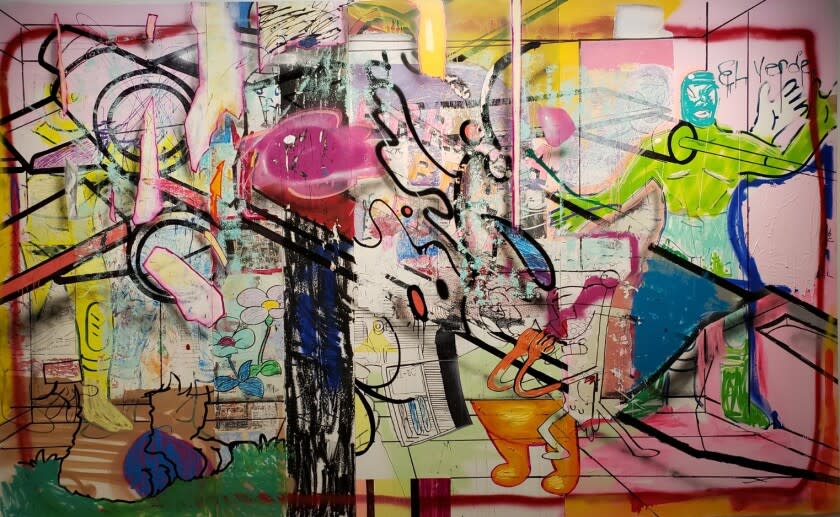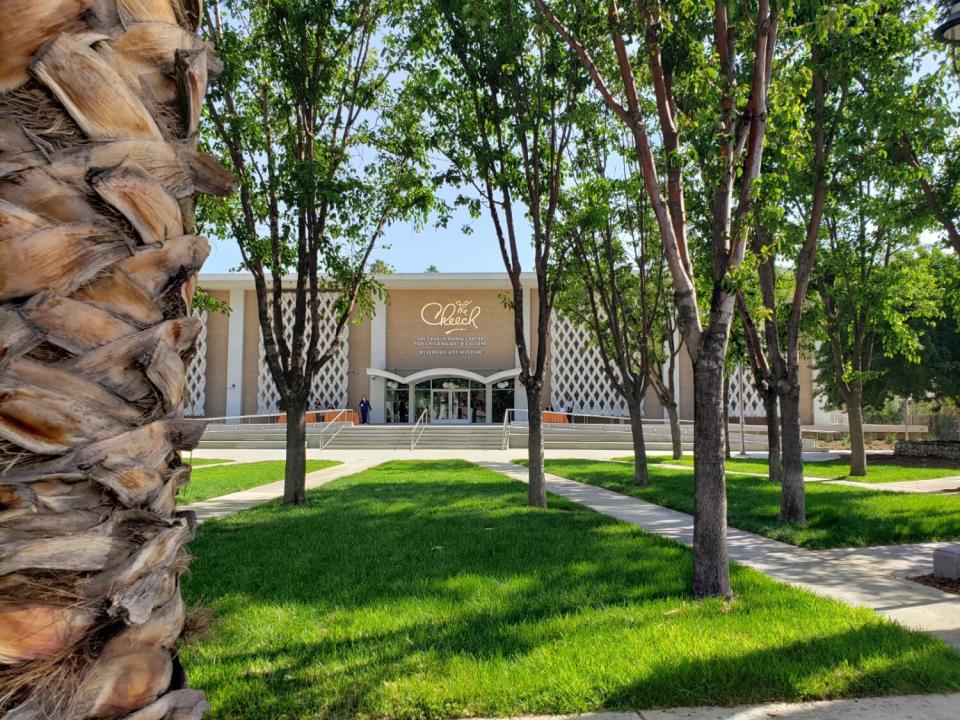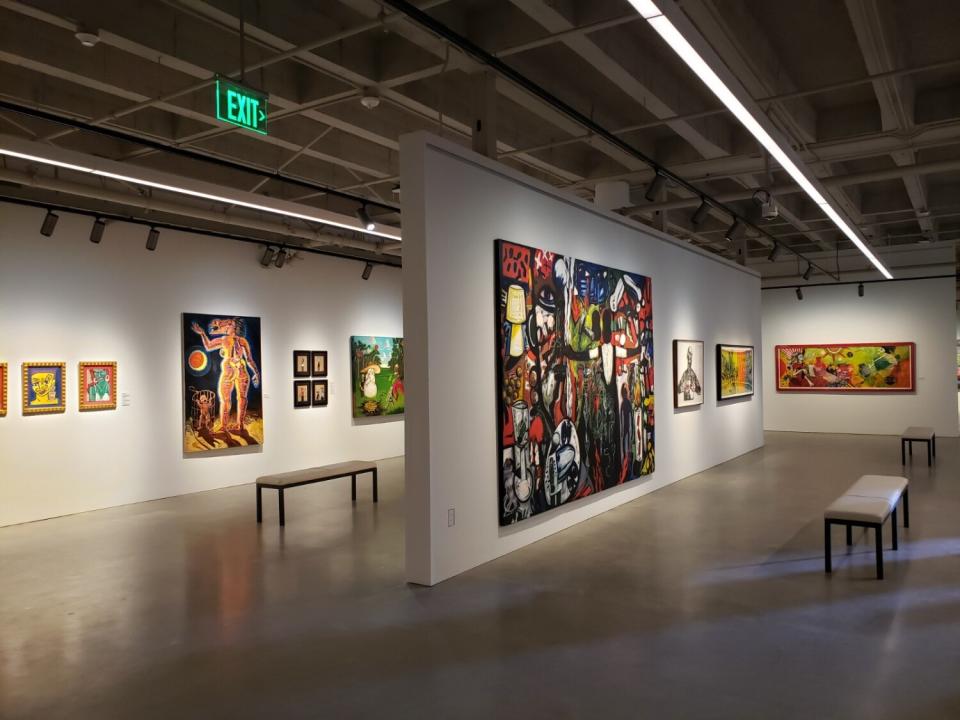Review: What is Chicano art? Riverside's new Cheech Marin Center offers an open-ended response
- Oops!Something went wrong.Please try again later.
- Oops!Something went wrong.Please try again later.

Saturday was a red-letter day for the history of art in Southern California. On June 18, the Riverside Art Museum opened its Cheech Marin Center for Chicano Art and Culture in a handsomely renovated, 61,000-square-foot former library building in the city center. No other museum presents a substantive permanent exhibition focused on any critically important facet of the region’s bountiful postwar art history, which is the basis on which Los Angeles has become a global cultural capital over the last generation.
Not Light and Space art, which grew from the perceptually acute, geometric, Hard Edge painting of the 1950s to become the first distinctive movement to emerge from L.A.
Not Assemblage, which brought together the anti-establishment ethos of the 1950s counterculture with the rise of the civil rights and Black arts movements to create a mode of working with found objects and salvaged materials still prominent in art today.
Not Feminist art, pioneered at outposts like CalArts and the Woman’s Building and quickly plugged into equal rights agendas being pursued by artists of all genders internationally.
Not … well, you get the idea. Southern California museums have exceptional individual holdings in these and other vital genres, including Chicano art, and some even have sizable collections in one or more of them. But nowhere can one go to see those art histories permanently displayed in any depth for public review. Instead, we get a bit of this, a bit of that — helpful if insufficient.
Until now.
The Cheech, as the Riverside facility has inevitably been nicknamed, given its celebrity origin in the art collection assembled over 30 years and donated by comedian-actor Cheech Marin, is a first. Chicano art is offered in concentration — serious, playful and in a sprawling range of visual vocabularies, some more successful than others, all worth taking in.

The two-story, 1964 library building stands across a side street from the fabled Mission Inn, the largest Mission Revival style building in the nation. The contrasting Midcentury Modern library, set back from the street across a tree-shaded lawn, was reconfigured and refurbished by Kulapat Yantrasast and WHY Architecture, working with preservation firm Page & Turnbull. The community base of Chicano art is acknowledged by a gallery located right inside the front door.
The ground floor hosts galleries for a permanent collection that currently stands at more than 550 works, primarily paintings and drawings. (The inaugural exhibition features 94 of them.) Among the artists are such well-established figures as Carlos Almaraz, Glugio “Gronk” Nicandro, Frank Romero, John M. Valadez and Patssi Valdez. There are also some nice surprises, including sensual small oil paintings of nighttime neighborhood food stands, glowing as modest havens of sustenance in the inky midnight blackness, by Joe Peña, a Texas artist new to me.
Upstairs are offices, an education center, an auditorium and temporary exhibition galleries. Currently showing is “Collidoscope,” a survey of the raucous pop sculptures of Guadalajara-born brothers Einar and Jamex De La Torre, who divide their time between studios in San Diego and Baja California. (A two-story vertical mural by the brothers is permanently installed in the building’s light-filled atrium.) Emblematic is a witty installation centered on a big Olmec head that the De La Torres merged with a lunar landing module, slyly musing on the hazy ancient origins of Mesoamerican society and contemporary “alien life.” (The lander's stabilizer feet are golden hubcaps.) Their sculptures’ elaborate fusions of traditional blown-glass, souvenir-shop lenticular optics and boisterous popular imagery might best be called Frantic Baroque.
The repurposed library building generally works well for museum galleries, with one caveat: Lighting is a problem. Drop ceilings have been removed and exposed ductwork painted an appealing light gray. But track lighting is limited in the possibilities for its placement, and hot spots rather than evenly light-washed walls are a distraction. The lighting needs work.

María Esther Fernández, artistic director of the Cheech, has overseen installation of the permanent collection in smart, loosely thematic groupings.
Cityscapes are prominent in the first room, subtly locating Chicano cultural expression as largely an urban phenomenon. The Chicano civil rights movement grew from the famous 1965 grape strike in California’s rural Central Valley, where Mexican migrants joined forces with protesting Filipino workers, but artists congregate in cities. The room is anchored by Romero’s monumental 1996 “The Arrest of the Paleteros,” in which police have swooped into L.A.'s Echo Park to bust startled women, men and kids happily enjoying popsicles from apparently unlicensed street vendors. The absurdity of the histrionic (and dangerous) scene, which is compressed into a lower third of the canvas, is heightened by the beautiful painterly sumptuousness of the palm-lined lake that fills the rest of the picture.
A transition between rooms begins with Almaraz’s florid 1982 “Sunset Crash,” an iconic image of flaming automobiles falling through the sky like asteroids after careening off a stacked freeway overpass, like the one in downtown Los Angeles that separates the city’s historically Latino-centered Eastside from its more Anglo Westside. History paintings born of frankly violent oppression unfurl, followed by galleries for portraits (including one of Marin by Eloy Torrez), operatic Surrealism and graffiti-inflected dreams. None of these thematic rooms is strictly defined, wisely avoiding narrow classification.
That’s important because it keeps a definition of Chicano art open-ended — a question more than an answer. What is Chicano art, anyway? Is it essentialist, characterized by the artist’s ethnicity? Or socially constructed, identifiable by subject matter? Determined by political affiliation? By the intersection of all of them?
What about Chicano abstraction? Is such a thing possible?

The closest here, in an installation otherwise entirely of figurative art, is “El Verde,” a marvelously composed recent painting by self-taught Texas artist Candelario Aguilar Jr. Over to one side, emerging from a densely layered swarm of gestural color across five panels, is a ghostly apparition of a wrestler who evokes the legendary El Veneno Verde — the Green Poison, a masked luchador. It’s as if a cultural hero has been virtually squeezed from a tube of Aguilar’s paint.
The inaugural installment of the permanent collection, titled “Cheech Collects,” marks the beginning of a shift from private taste to public history. Marin’s personal collection has traveled widely, including a show at the Los Angeles County Museum of Art, but it could not escape the limitation of merely promoting one person’s enthusiasm — a pitfall for any private collection encountered in an art-historical setting. Marin’s tastes, for instance, are largely centered on L.A. painting since the 1980s, primarily by men, while Chicano art is more wide-ranging in scope. His collection is a terrific nucleus for the museum, but growth and diversification are essential. In coming years, “Cheech Collects” will need to evolve into “The Cheech Collects,” moving from private to institutional and delving into extensive scholarship on Chicano art history.
There’s work ahead. A welcome sign that it is happening already is the inclusion of two large, haunting pastels by Chicana feminist artist Judithe Hernández, a former member of the 1970s Chicano collective Los Four. Hernández is slated for a retrospective at the museum next year, and the two pastels — one a diptych seven feet wide — are from her ongoing series of poetic meditations on the unsolved abductions of women working in the maquiladoras around the Mexican border city of Juárez. According to the works' labels, they are recent museum acquisitions.
More of that will surely happen. The Chicano generation of artists and activists that emerged in the late 1960s knew that self-empowerment requires historical knowledge. The same goes for art, which propagates and adapts from other art. Systematic study of usable, relevant Chicano art history is now underway in Riverside.
This story originally appeared in Los Angeles Times.

